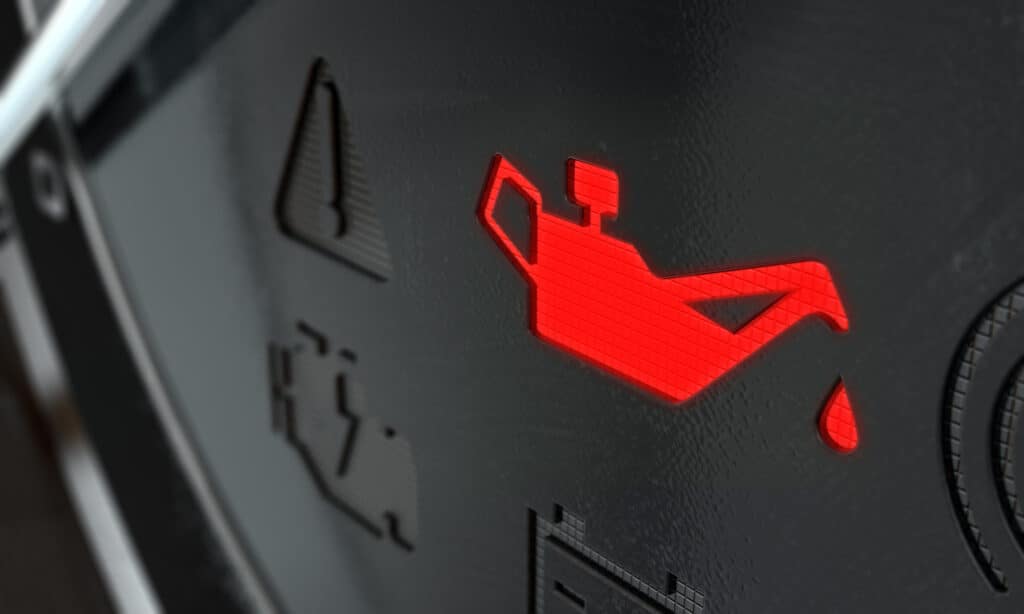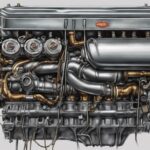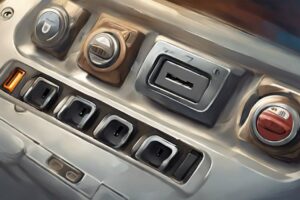When the check engine light comes on, it can be a cause for concern. Many drivers wonder if low oil could be the culprit. While low oil can cause a variety of engine problems, it is not typically the reason for the check engine light to illuminate. It is more common for low oil levels to trigger the check oil light on the dashboard.
The check engine light is a warning that something is wrong with the engine or emissions system. It could be caused by a range of issues, such as a faulty oxygen sensor, spark plugs, or catalytic converter. When the light comes on, it is recommended to take the vehicle to a mechanic to have it diagnosed as ignoring the problem could lead to further damage and a more expensive repair bill.
While low oil may not always directly be the cause of the check engine light, it is still important to maintain proper oil levels in the engine.
Running the engine with low oil can cause damage to internal components, such as the cam phasers, valves, and pistons. It can also lead to reduced or lost compression, which can result in engine failure.
Can Low Oil Cause the Check Engine Light to Come On?
The check engine light is a warning system that alerts drivers to potential problems with their vehicle. It’s a common misconception that low oil levels can directly cause the check engine light to turn on.
However, this is not entirely accurate. Unlike low coolant, low oil levels will not directly cause the check engine light to come on, but it can lead to other issues that can trigger the warning system.
When the oil level in the engine is too low, it can cause the oil pressure to drop. This, in turn, can cause the engine to work harder, leading to increased wear and tear on the engine components. The drop in oil pressure can also cause the engine to overheat, which can lead to further damage.

Low oil levels can cause significant damage to the engine and other systems, which can ultimately lead to the check engine light turning on. When the engine is running with low oil levels, it can cause the engine to seize up, leading to damage to the cam phasers, valves, and pistons. This damage can result in reduced or lost compression, leading to a decrease in engine performance.
Over time, low oil levels can cause damage to the engine bearings, which can lead to engine failure.
The lack of oil can also cause the engine to overheat, leading to damage to the head gasket and other engine components.
What Are The Symptoms of Low Oil That May Trigger A Check Engine Light?
Low engine oil can cause a variety of symptoms that can be easily recognized. The most common symptoms include:
- Illuminated oil pressure warning light on the dashboard
- Engine knocking or ticking sounds
- Low oil level on the dipstick
When the engine oil level is low, the oil pressure drops, and the oil pressure warning light illuminates on the dashboard. This is the most definitive way to tell that the engine is running low on oil.
The oil pressure warning light is usually red or yellow and looks like an oil can with a drip coming out of it.
Another symptom of low oil is engine knocking or ticking sounds. When the engine oil level is low, the engine components do not receive enough lubrication, causing metal-to-metal contact, which results in knocking or ticking sounds. If left unattended, this can cause serious engine damage.
Another way to determine the oil level is by checking the dipstick, if there is one fitted to your car. The dipstick is a long, thin metal rod that is used to measure the oil level in the engine. If the oil level is below the minimum level, it indicates that the engine is running low on oil.
Here is a summary of the most common symptoms of low engine oil that could lead to the check engine light coming on:
| Symptom | Description | Severity/Potential Engine Damage |
|---|---|---|
| Engine knocking or ticking | Low engine oil can cause the engine to make knocking or ticking noises, which can be caused by metal parts rubbing together due to lack of lubrication. | High |
| Low oil pressure warning light | If the oil pressure warning light on the dashboard turns on, it’s an indication that the engine oil pressure is low. | High |
| Engine overheating | Low engine oil can cause the engine to overheat, as the oil helps to dissipate heat from the engine. Without sufficient oil, the engine can overheat and cause damage. | High |
| Reduced engine performance | Low engine oil can cause a reduction in engine performance, including a decrease in fuel economy, loss of power, and engine stalling. | Medium |
| Burning oil smell | A burning oil smell from your vehicle and subsequent low oil level could indicate an oil leak from one of the engine components. This oil may drip on a hot engine part, causing that burning smell. | Low |
| Increased engine wear | Low engine oil can cause increased engine wear and damage, as the metal parts of the engine rub against each other without proper lubrication. This can lead to costly repairs or even engine failure. |
How Can Low Oil Symptoms Trigger the Check Engine Light?
In addition to the symptoms mentioned above, low engine oil can also trigger the check engine light. The check engine light is a warning light on the dashboard that illuminates when the engine control unit (ECU) detects a problem with the engine or emission control system.
When the engine oil level is low, it can cause a drop in oil pressure, which triggers the oil pressure warning light. If the oil pressure drops too low, it can also trigger the check engine light. This is because the ECU monitors the oil pressure sensor and uses the data to control the engine’s performance.
Similarly, engine knocking or ticking sounds can also trigger the check engine light. When the engine components do not receive enough lubrication, it can cause serious engine damage, which can trigger the check engine light.
Low oil level as measured by the dipstick can also trigger the check engine light. If the oil level is too low, it can cause the engine to overheat, which can trigger the check engine light.
So it’s clear that low engine oil can cause a variety of symptoms that can be easily recognized. These symptoms can also trigger the check engine light, as low oil can cause damage to the engine and can affect its performance.
What Are Some Other Common Causes of the Check Engine Light?
When the check engine light comes on, its generally a sign of a problem with how the engine is running. Engine sensors are constantly monitoring and relaying information to the ECU about the current state of the engine.
If one of the sensors detects a problem then this will trigger the check engine light to come on or to flash.
While low oil pressure is one of the possible causes, there are several other reasons why the light might turn on. Here are seven common causes of the check engine light:
| Cause | Description |
|---|---|
| Loose or damaged gas cap | If the gas cap is not tightened properly, it can cause the check engine light to turn on. |
| Faulty oxygen sensor | The oxygen sensor measures the amount of oxygen in the exhaust and helps regulate the air-fuel mixture. If it is faulty, it can cause the check engine light to turn on. |
| Malfunctioning catalytic converter | The catalytic converter reduces harmful emissions from the exhaust. If it is not working properly, it can cause the check engine light to turn on. |
| Bad spark plugs or wires | The spark plugs and wires ignite the fuel in the engine. If they are faulty, it can cause the check engine light to turn on. |
| Failed mass airflow sensor | The mass airflow sensor measures the amount of air entering the engine. If it fails, it can cause the check engine light to turn on. |
| Issues with the EGR system | The EGR system recirculates exhaust gas back into the engine to reduce emissions. If it is not working properly, it can cause the check engine light to turn on. |
| Problems with the ignition coils | The ignition coils provide power to the spark plugs. If they are not working properly, it can cause the check engine light to turn on. |
Some of these issues can be mistaken for low oil pressure, which is why it is important to have the vehicle checked by a professional mechanic to diagnose the problem accurately.
For example, a malfunctioning oxygen sensor can cause the engine to burn more oil than usual, leading to low oil pressure. Similarly, a bad catalytic converter can cause the engine to overheat, which can also trigger the low oil pressure warning.
In some cases, the check engine light might turn on due to a loose or damaged gas cap. This can cause the engine to run less efficiently, which can lead to increased oil consumption and low oil pressure. It is important to check the gas cap regularly and replace it if it is damaged or worn out.
What Should You Do When The Check Engine Light Comes On?
When the check engine light comes on, the first thing you should do is not to panic. The check engine light is an indication that there is a problem with the vehicle’s engine or emissions system, but it doesn’t necessarily mean that there is a serious issue.
If the check engine light is accompanied by a low engine oil warning light then you should stop running the engine as soon as possible and top up the oil.
If the check engine light stays on and the low oil level light goes off, keep a close eye on the oil level and drive the car for 10-15 miles to see if the check engine light turns off by itself.
If the check engine light stays on then you should carry out a diagnostic readout of the ECU memory to see of there are any error codes that may point to the source of the problem. Failing this, you should get the engine checked by a mechanic before further damage occurs.
Here are some other steps you can take when the check engine light comes on:
- Check the gas cap: Sometimes, a loose or damaged gas cap can trigger the check engine light. Check the gas cap and tighten it if necessary.
- Check for other symptoms: If the check engine light is accompanied by other symptoms, such as a loss of power or strange noises, reduce your speed and try to reduce the demands on the engine. For example, you may want to turn off the air conditioning or reduce your speed to avoid putting additional strain on the engine.
- Check the owner’s manual: Your vehicle’s owner’s manual may provide information on what to do when the check engine light comes on. It may also provide information on what the different warning lights mean and how to troubleshoot common issues.
- Get the vehicle inspected: If the check engine light remains on it’s important to have the vehicle inspected by a qualified mechanic. The mechanic can use a diagnostic tool to read the codes stored in the vehicle’s computer and determine the cause of the check engine light. They can also perform any necessary repairs to ensure that the vehicle is running properly.
It’s important to note that ignoring the check engine light can lead to more serious issues down the road, including engine damage or failure. If the check engine light comes on, it’s important to take it seriously and take the necessary steps to diagnose and fix the problem.
What are the consequences of driving with the check engine light on?
When the check engine light comes on it’s a warning that something is wrong with the vehicle.
If the low engine oil or low oil pressure light is also on then ignoring these warning lights and continuing to drive can lead to serious damage to the engine as follows:
1. Engine overheating
One of the possible consequences of driving with the check engine light on is engine overheating. The check engine light can come on due to a faulty thermostat, broken water pump, or low coolant level. If the engine overheats, it can cause severe damage to the engine, leading to expensive repairs or even engine replacement.
2. Misfires and engine damage
A misfire occurs when the air/fuel mixture in one or more cylinders fails to ignite properly. This can cause a rough idle, poor acceleration, and decreased fuel economy. If left unaddressed, misfires can cause serious engine damage, including damage to the pistons, valves, and cylinder walls.
3. Catalytic converter failure
If the check engine light is on due to a faulty oxygen sensor or other emission control system malfunction, it can cause the catalytic converter to fail. A failed catalytic converter can lead to decreased engine performance, increased emissions, and expensive repairs.
4. Oil leak and burning oil smell
If the check engine light is on due to low oil pressure or a low oil level, it can cause an oil leak or burning oil smell. Driving with low oil levels can cause serious engine damage, leading to costly repairs or engine replacement.
How To Diagnose And Repair The Check Engine Light If The Low Oil Pressure Light Is Also On
When trying to determine the cause of a check engine light it’s usually a good idea to start with a diagnostic readout of the ECU memory to check for any error codes that may be present.
If the low oil pressure light is also on, then there may be diagnostic codes associated with oil pressure or low oil. Here are some common OBD error codes to watch out for:
| OBD Error Code | Description |
|---|---|
| P0520 | Engine Oil Pressure Sensor/Switch Circuit Malfunction |
| P0521 | Engine Oil Pressure Sensor/Switch Range/Performance |
| P0522 | Engine Oil Pressure Sensor/Switch Circuit Low Voltage |
| P0523 | Engine Oil Pressure Sensor/Switch Circuit High Voltage |
| P0524 | Engine Oil Pressure Too Low |
| P0525 | Engine Oil Temperature Sensor Circuit Malfunction |
| P0526 | Engine Oil Temperature Sensor Circuit Range/Performance |
| P0527 | Engine Oil Temperature Sensor Circuit Low Voltage |
| P0528 | Engine Oil Temperature Sensor Circuit High Voltage |
- Check the oil level: The first step in diagnosing the check engine light and low oil pressure light is to check the oil level. If the oil level is low, add oil to the engine until it reaches the proper level. If the oil level is fine, move on to the next step.
- Check the oil pressure sensor: The low oil pressure light may be triggered by a faulty oil pressure sensor. A mechanic can use a diagnostic tool to read the codes stored in the vehicle’s computer and determine if the oil pressure sensor is faulty. If it is, the sensor will need to be replaced.
- Check the oil pressure switch: If the oil pressure sensor is not the issue, the oil pressure switch may be faulty. A mechanic can test the switch and replace it if necessary.
- Inspect the oil pump: If the oil pressure sensor and switch are functioning properly, the oil pump may be the issue. A mechanic can perform a pressure test on the oil pump to determine if it is working properly. If it is not, the pump will need to be replaced.
- Check for engine damage: If the check engine light and low oil pressure light are both on, it’s possible that there is engine damage. A mechanic can perform a visual inspection of the engine and perform tests to determine if there is any damage. If there is, the engine may need to be repaired or replaced.
It’s important to note that diagnosing and repairing the check engine light and low oil pressure light can be tricky, and it’s often best to have your car inspected by a qualified mechanic to properly diagnose and fix any issues with the engine or oil system. A mechanic will have the tools and expertise to properly diagnose and repair the issue.
How To Prevent A Check Engine Light Associated With Low Oil
Regular maintenance of a vehicle is a crucial aspect of preventing issues that can lead to the check engine light turning on. One of the most important maintenance tasks is ensuring that the engine oil is at the proper level and has not become contaminated.
Low oil levels can lead to low oil pressure and cause the check engine light to turn on. To avoid this, it is recommended to check the oil level regularly, especially before and after long trips.
Regular oil changes are also essential in preventing low oil levels and other engine issues. Old oil can become contaminated with dirt and debris, which can lead to clogs in the engine and reduce oil pressure. It is recommended to change the oil every 5,000 to 7,500 miles, depending on the vehicle and driving conditions.
In addition to regular oil changes, it is important to inspect the engine for leaks or other issues that can cause low oil levels.
Leaks can occur in various parts of the engine, including the oil pan, valve cover gasket, and oil filter. Inspecting these parts regularly can help catch any leaks before they cause significant engine damage.
Aside from regular oil changes and inspections, there are other preventative measures that can help avoid issues that can trigger the check engine light. Here are a few examples:
- Use the proper oil type and viscosity recommended by the vehicle manufacturer
- Avoid driving in extreme conditions, such as high temperatures or dusty environments
- Avoid overloading the vehicle or towing beyond the recommended capacity
- Replace the air filter regularly to prevent clogs and reduce engine strain











I’ve been religiously checking my oil levels and making sure it’s not low, but my check engine light still came on recently. Could other maintenance issues or parts failure cause this light to activate even if my oil level is alright?
I’ve been really cautious about my car maintenance, especially with the oil levels and regular check-ups, but recently, my check engine light turned on out of nowhere. I didn’t notice any strange behavior from my car before the light came on, and there weren’t any odd sounds or performance issues. Could it still be an oil-related issue even if I’ve been maintaining proper oil levels and there are no apparent oil leaks or low oil pressure warnings?